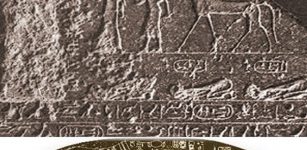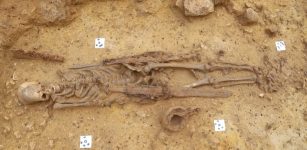The Govan Stones – Treasures From The Viking Era In Britain
A. Sutherland - AncientPages.com - An extraordinary and priceless collection of Viking-age monuments, located at Govan Old Parish Church, Glasgow, Scotland, represents one of the best collections of early medieval sculpture anywhere in the British Isles.
Govan stones. Image credit: Deadmanjones - CC BY-SA 3.0
Carved in the 9th – 11th centuries, the Govan Stones probably commemorate the power of those who ruled the native Briton Kingdom of Strathclyde, the lost kingdom of the northern Britons.
The total number of stones was forty-five, but many were lost. They all had a large cross carved on the front, surrounded by Celtic interlace patterns. Interestingly, the missing ones were the same type: the horizontal cross-slab, designed to be placed on top of a grave.
By the end of the nineteenth century, many ancient carvings had worn away after a thousand years of exposure to the elements,
The Govan medieval stones are covered with classic Viking patterns, elaborate carvings of crosses, and cross shafts. Still, they are not found in Scandinavia. Also known as “Hogback monuments”, these house-shaped Viking tombstones (dated to the 10th – 12th century) have been found in northern England and even as far north as the River Tyne.
 A side of the Govan Sarcophagus, with animal and interlace carvings. Image credit: Viking870 - CC BY-SA 4.0
A side of the Govan Sarcophagus, with animal and interlace carvings. Image credit: Viking870 - CC BY-SA 4.0
However, they are considered a remarkable and odd invention associated with the Viking settlers, who built the tombs of the dead in Norwegian style. Did the settlers intend to design the coffins to represent Viking longhouses for the deceased to continue living in the afterlife?
The Govan Sarcophagus with warrior figures is particularly interesting, the only one from solid stone from pre-Norman, northern Britain. It was discovered in the church graveyard in December 1855 and brought into the church in 1908.
The sarcophagus is believed to commemorate St. Constantine, the son of Pictish king Kenneth MacAlpin, King of Dál Riada (841–850), King of the Picts (843–858), and the first King of Alba (843–858).
Side of the Viking-Age Govan Sarcophagus thought to depict a royal saint killed by Vikings in the 870s. Image credit: Viking870 - CC BY-SA 4.0
The coffin is carved from a block of sandstone, with the sides covered with panels depicting animals and a horseman alongside ribbon motifs. Perhaps, it was intended to hold the mortal remains of the founder of the medieval Church of St Constantine, built on the site where Govan Old Parish Church stands today.
There are no religious motifs on the stones depicting warriors and animals. Otherwise, it could suggest that these were gravestones for the local clergy when Govan was a center of royal power in the kingdom of Strathclyde. Still, there is a distinct possibility that the stones commemorated the warrior aristocracy.
The names of the deceased are unknown, for no early inscriptions are visible on any of the Govan stones.
Written by – A. Sutherland - AncientPages.com Senior Staff Writer
Updated on February 26, 2023
Copyright © AncientPages.com All rights reserved. This material may not be published, broadcast, rewritten or redistributed in whole or part without the express written permission of AncientPages.com
Expand for references
More From Ancient Pages
-
 Grolier Codex – Oldest, Unique, Genuine Pre-Columbian Maya Manuscript That Survived Spanish Inquisition
Artifacts | Jan 20, 2018
Grolier Codex – Oldest, Unique, Genuine Pre-Columbian Maya Manuscript That Survived Spanish Inquisition
Artifacts | Jan 20, 2018 -
 Infamous Queen Jezebel And Her Ancient Seal
Featured Stories | Feb 13, 2016
Infamous Queen Jezebel And Her Ancient Seal
Featured Stories | Feb 13, 2016 -
 Face Of Egyptian Man Who Lived 35,000 Years Ago Reconstructed
Archaeology | Apr 7, 2023
Face Of Egyptian Man Who Lived 35,000 Years Ago Reconstructed
Archaeology | Apr 7, 2023 -
 Three Bronze Age Chariots, Shields, Daggers And Decorated Coffins Unearthed In Northern India
Archaeology | Jun 7, 2018
Three Bronze Age Chariots, Shields, Daggers And Decorated Coffins Unearthed In Northern India
Archaeology | Jun 7, 2018 -
 Ancient Maya Built Sophisticated Water Filters To Obtain Drinking Water
Archaeology | Oct 23, 2020
Ancient Maya Built Sophisticated Water Filters To Obtain Drinking Water
Archaeology | Oct 23, 2020 -
 Neanderthals In Swabian Jura Used Complex Tool-Making Techniques 45,000 Years Ago
Archaeology | Sep 8, 2021
Neanderthals In Swabian Jura Used Complex Tool-Making Techniques 45,000 Years Ago
Archaeology | Sep 8, 2021 -
 Never-Before-Seen 3,000-Year-Old Paintings Of Egyptian Goddess Amentet Discovered Inside Coffin Of A Mummy
News | Apr 7, 2020
Never-Before-Seen 3,000-Year-Old Paintings Of Egyptian Goddess Amentet Discovered Inside Coffin Of A Mummy
News | Apr 7, 2020 -
 Ancient DNA Has Traced Large-Scale Migrations Into Bronze Age Britain And The Emergence of The Celtic Language
Archaeology | Dec 30, 2021
Ancient DNA Has Traced Large-Scale Migrations Into Bronze Age Britain And The Emergence of The Celtic Language
Archaeology | Dec 30, 2021 -
 Ancient Stela Of Piankhi – King Of Napata, Rightful Ruler And Maintainer Of Maat
Featured Stories | Apr 25, 2018
Ancient Stela Of Piankhi – King Of Napata, Rightful Ruler And Maintainer Of Maat
Featured Stories | Apr 25, 2018 -
 Why Were Ancient ‘Puppet’ Figurines Placed Atop A Pre-Columbian Pyramid In El Salvador?
Archaeology | Mar 5, 2025
Why Were Ancient ‘Puppet’ Figurines Placed Atop A Pre-Columbian Pyramid In El Salvador?
Archaeology | Mar 5, 2025 -
 Forseti: Norse God Of Justice And Lawmaker Who Lived In A Shining House
Featured Stories | May 1, 2016
Forseti: Norse God Of Justice And Lawmaker Who Lived In A Shining House
Featured Stories | May 1, 2016 -
 Unraveling The Mystery Of A Lost Biblical Underground World – Is A Precious Ancient Artifact The Answer?
Ancient Mysteries | May 30, 2018
Unraveling The Mystery Of A Lost Biblical Underground World – Is A Precious Ancient Artifact The Answer?
Ancient Mysteries | May 30, 2018 -
 Untouched 1,300-Year-Old Grave Of Merovingian Warrior With Complete Armor Found In Ingelheim, Germany
Archaeology | Sep 19, 2023
Untouched 1,300-Year-Old Grave Of Merovingian Warrior With Complete Armor Found In Ingelheim, Germany
Archaeology | Sep 19, 2023 -
 Celts: Facts And History About The Powerful And Intriguing People Of Central And Northern Europe
Civilizations | Aug 7, 2022
Celts: Facts And History About The Powerful And Intriguing People Of Central And Northern Europe
Civilizations | Aug 7, 2022 -
 Ancient Egyptians Played Bowling 5,000 Years Ago
Ancient History Facts | Feb 22, 2016
Ancient Egyptians Played Bowling 5,000 Years Ago
Ancient History Facts | Feb 22, 2016 -
 Knowledge Of Secret Ancient Underground Civilization Revealed By Maya Priests
Ancient Mysteries | Nov 1, 2018
Knowledge Of Secret Ancient Underground Civilization Revealed By Maya Priests
Ancient Mysteries | Nov 1, 2018 -
 Arsinoe II Rose To Power Through Manipulations, Murder, Conspiracies And Became Worshiped As A Goddess
Featured Stories | Apr 26, 2019
Arsinoe II Rose To Power Through Manipulations, Murder, Conspiracies And Became Worshiped As A Goddess
Featured Stories | Apr 26, 2019 -
 Biblical Event Verified By Study Of Earth’s Magnetic Field?
Archaeology | Jan 4, 2024
Biblical Event Verified By Study Of Earth’s Magnetic Field?
Archaeology | Jan 4, 2024 -
 Massive Menhir Champ Dolent Built By Fairies In Ancient Beliefs Of Brittany’s People
Featured Stories | Jan 13, 2025
Massive Menhir Champ Dolent Built By Fairies In Ancient Beliefs Of Brittany’s People
Featured Stories | Jan 13, 2025 -
 3,500-Year-Old Tomb Of Egyptian Goldsmith Discovered
Archaeology | Sep 10, 2017
3,500-Year-Old Tomb Of Egyptian Goldsmith Discovered
Archaeology | Sep 10, 2017


